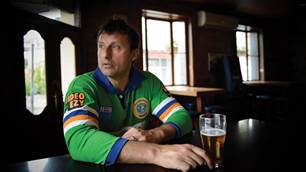Is Stuart Gibson the fittest man in Australia?
Is Stuart Gibson the fittest man in Australia?
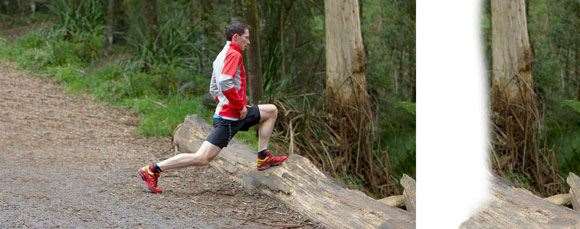 The technique for ultra-running is all about conserving energy,
The technique for ultra-running is all about conserving energy,Images: Joseph Feil
The Glasgow-born, Melbourne-settled ultra-runner sprung to the attention of the athletic fraternity in April this year when he bagged a stunning 11th-place finish at the Marathon des Sables. For the uninitiated, this race traces a 243km line through the Moroccan dunes of the Sahara Desert. Runners have to carry their own provisions. By mid-afternoon, temperatures nudge 45 degrees, at dawn it drops to zero. In his debut race, Gibson finished in 25:31.45. Since then he’s obliterated the race record at the North Face 100 (a 100km gallop through the Blue Mountains), finishing hand in hand with defending champ Andrew Lee in 9:54.19. This month he’s off to Gibraltar to contest the World 100km Championships. A week later he’ll be back home for the Eureka Tower Climb, looking to run the 1958 steps of Melbourne’s 279m-high tower in eight minutes.
So, is there a fitter man in this wide, brown land? If there is, we can’t think of him ... Here’s why.
The game
“I represented Great Britain at the European Championships a decade ago; 1500m was my distance. But I sustained a significant Achilles injury and just fell out of the sport. I came to Australia five years ago and slowly started getting back into my running. Nothing serious, just a few half-marathons. Then I managed to get an entry into the Marathon des Sables and thought, ‘Right, this is a chance to get myself pretty fit again.’ So I slowly built up ...
“I really think ultra-running is going to take off over the next few years. I reckon the sport at the moment is where mountain biking was ten years ago. There’s a vast amount of people who have run a marathon and want to know what they can put their body through next – ultra-running really captures their imagination. I reckon it’ll become a true mainstream sport in five years’ time.”
Clocking the kays
“My training is all about mileage. Over the five months leading into a big event like the Marathon des Sables, I probably average 140-to-150km a week. About four weeks out from the race I’ll peak at 180km. Ninety-five per cent of that running will be off-road: trail running in the Victorian high country or sand running down in Wilsons Promontory. You know, it’s not just running down the promenade – it’s tough terrain, tough on the ankles. I’m running on fire trails and single tracks, a mixture of walking paths and mountain bike trails.
“I still work during the week, so Monday-to- Friday runs tend to be shorter, high-intensity; 20km, which will take around 90 minutes over a strenuous course. On Saturday and Sunday I do my big-mileage stuff. These are my four-to-five-hour runs. Obviously I’m running at a much lower intensity, down to 8-to-10km an hour.
“The key to ultra-running is getting the body used to running very long distances. We talk about four hours as being the magic mark. When you’re training for a standard big-city marathon, no one tends to go over the three-hour mark in their training. But ultra-running has different demands. Once you go past that four-hour mark, your body’s using different energy systems. If you haven’t tested your body beyond that barrier, it’ll really break down. So, for instance, on a Saturday I might go out for a three-hour run, come back to the car, take on some food, then go back out for another two hours.”
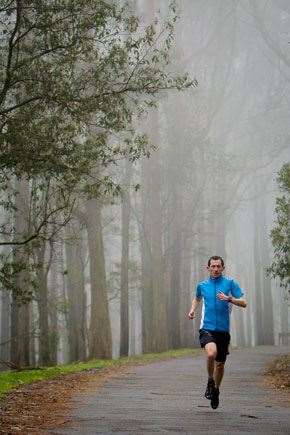 “My training is all about mileage."
“My training is all about mileage."Images: Joseph Feil
Slow down
“About four weeks out from a big event, I’ll start to taper. I’m always experimenting with different tapering regimes, because tapering is a very personal thing. Some people don’t like tapering; their bodies don’t like the break, so they might only taper over five days ...
“Personally, I like to start tapering four weeks out, but it’s a very gradual taper. I might go from 180km one week, to 150 the next, then 130, then 90. The week before, the graph really drops off and I might only do, say, 60km. The week before the North Face 100 in the Blue Mountains, I only ran 45km. I like that gradual taper, but some of the guys I train with will really start to taper three weeks before. Their numbers will drop really quickly.”
Fast food
“I’m always experimenting with my food during runs. It’s a very personal thing. Some people might like bananas. Others might like artificial, high-carb enduro bars. At the moment I’m actually experimenting with some baby food. It’s in those squeezy packets and it’s very high-carb. I also like date paste and peanut butter – the carb concentration in those is amazing.
“The key is to get your stomach to accept the food, to process it after four or five hours of running. What tends to happen is that you take on all these artificial electrolytes and salt tablets and it suppresses your diet. You don’t feel hungry, but you must start to take on food otherwise you’re going to run out of fuel. I’ve really suffered from that in the past – you can actually feel your body starting to break down. It’s not a pleasant feeling.”
Holding weight
“I’m quite lucky as an ultra-runner because my weight doesn’t fluctuate that much. At the moment I’m coming back from an ankle injury and I’m probably sitting at 69kg.When I raced the North Face 100 this year my weight was
about 67kg. So it’s not a significant change.“But when you’re running high mileage each week your body burns thousands and thousands of calories, and to maintain your weight you have to eat a lot of complex carbohydrates. I find plain boiled rice is the best thing for ultra-running. Potatoes and pasta tend to be quite heavy and my body uses a lot of energy breaking them down. I find rice much more palatable, and it’s been proven that it’s a much slower burner. So that’s generally the choice of ultra-runners. I’d say my diet would be 90 per cent carbohydrate, 5 per cent protein and then the usual vitamins and minerals. I drink a lot of vegetable juices and fruit smoothies.
“The day before a race I’ll drink at least three to four litres of water with electrolyte powder mixed in. The night before I’ll have a boring rice dish - you’ve got to avoid spicy sauces. On the morning of the race, two hours before the start, I’ll have breakfast – two slices of toast with honey and peanut butter, a cup or two of yoghurt, and then I’ll start sipping on electrolytes. This tends to be early because most of these races start at five or six in the morning, but you have to eat two hours before so your body’s got a chance to break down that food.
“For the first hour and a half of a race you’re barely eating anything at all – you’re just letting your body settle into the rhythm. But after that you’ve got to start taking on liquid and salt tablets. After two and half hours you’ve probably used up 50 per cent of your glycogen, so you really need to start taking on food. Some of the older guys I run with at the South Melbourne Athletic Club used to down a tin of sweetened condensed milk. I’d be like, ‘Oh, yuk.’”
 Stuart Gibson Portrait
Stuart Gibson PortraitImages: Joseph Feil
Happy feet
“I tend to mix and match my running shoes – they’re on a bit of a rotation – but I’ll still go through eight pairs a year. You’ve basically got three types of shoe: your general road-running shoe, your intermediate trail-running shoe and then your hard-core trail-running shoe. These heavy shoes have a very aggressive sole on them, almost like rubbery football studs. It depends on the course as to what footwear you go with. The Bogong to Hotham race is probably considered the hardest in Australia; it’s all technical single track. For that race I’d choose a very aggressive trail shoe. But a lot of other races, the North Face 100 for example, are a mix of fire trails and single track, so for those events I use an average trail shoe with a much more refined sole. You have to do your homework on a course before deciding what to wear.”
Just relax
“I’ve got a middle-distance background. Ten years ago I was at university in the UK and I used to run competitive middle-distance races, so I was always honing my track technique. But the technique for ultra-running is all about conserving energy. It’s about staying really relaxed, remaining as efficient as possible. Your knee lift is very low, your stride is shortened, your arms are low, your shoulders aren’t tensed. You’re just looking at the ground and choosing your line. At points in a race, say the last ten kilometres, you might want to attack a hill. Then you increase your stride length, get a little more aggressive on your arm movement. But that happens very rarely in ultra-running because races are seldom down to sprint finishes – most of the time you tend to be out on your own.”
Going up
“The first year I did the Eureka Tower climb, it was a bit of a charity thing, but last year I took it a bit more seriously and started doing a few sharper sessions. Basically, I broke it down and said to myself, ‘I think I can climb this in eight minutes.’ Then I tried to break that eight-minute period down. So for the first three to four minutes I’m running hard, doing three to four stairs at a time. Then I cut that back to two stairs at a time, because my heart rate’s at its maximum. Then, for the last minute, I’m just trying to hold on. So I simulate that at the 1000 Steps at Ferntree Gully. I work in eight-minute blocks where I run really hard for four minutes at a longer stride, trying to build my lactic acid, putting my body in oxygen debt. Then I shorten my stride for another three minutes and try to buffer that lactic acid, to manage it, using my middle-distance background. Then for the last minute it’s all about controlling my style, holding my form, controlling my heart rate, because I’m working at my maximum. It’s not much fun!”
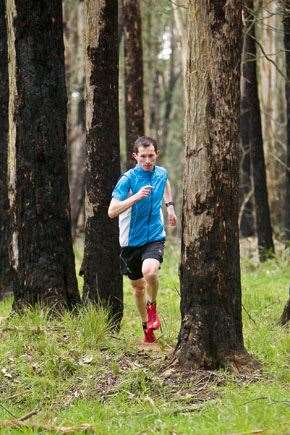 “I really think ultra-running is going to take off over the next few years.”
“I really think ultra-running is going to take off over the next few years.”Images: Joseph Feil
Injury prevention
“At the moment I’ve got a slight injury in my ankle. At first I thought it was a stress fracture in my fibula, but MRIs have shown it’s just a bit of tendonitis. I’m on anti-inflammatory tablets and I’m trying to watch my kilometres, making sure I’m not doing too much.
“I’m probably not the best person to talk about injury prevention because I tend to be a bit sloppy there. But I always take ice baths after a hard weekend of running. On Sunday nights I’ll pop down to my local pool at Albert Park where you can sit in ice baths for 15 minutes. It’s incredible how that helps to repair damaged tissue. I’m not sure of the science, but if I have an ice bath after a hard-core weekend, by Tuesday morning my legs are ready to go for a hard run again. Compare that to no ice bath and I wouldn’t be right till Thursday. It’s all about cutting down that recovery period.”
Fry up
“After the Marathon des Sables this year, I lost 18 per cent of my bodyweight – although that was an extreme case. As I was standing on the start line it was 39 degrees and I could feel the moisture being sucked out of my body. It was probably the first time I’ve been concerned about my health during a race. I drank half of my water before we even started. By the 60km mark I just blew up; my body ran out of fluid. My urine became so salt-saturated it caused an infection in my bladder. At the end of that stage I passed a lot of blood. I was pretty concerned but the doctors just gave me antibiotics and told me to drink all of my water rations. But because of the antibiotics, I couldn’t hold food down. So I virtually ran two marathons on no food. By the end, my body was just consuming itself.
“After that race I went back to Scotland to visit my parents and I was eating a very high-fat diet, a lot of fried food, fried sausages, fried bacon. Obviously I was complementing that with fresh fruit and vegetables – and I almost overdosed on vitamin C and iron tablets – but there was a lot of fried stuff. I finished that race at 59kg and I’d put ten kilos back on within four weeks.”
– Aaron Scott
Related Articles

The Ultimate NRL 2020 Season Preview
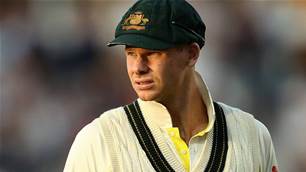
December 2019 Inside Sport hits ‘em for six
